1993 CHEVROLET CAVALIER heater
[x] Cancel search: heaterPage 49 of 308
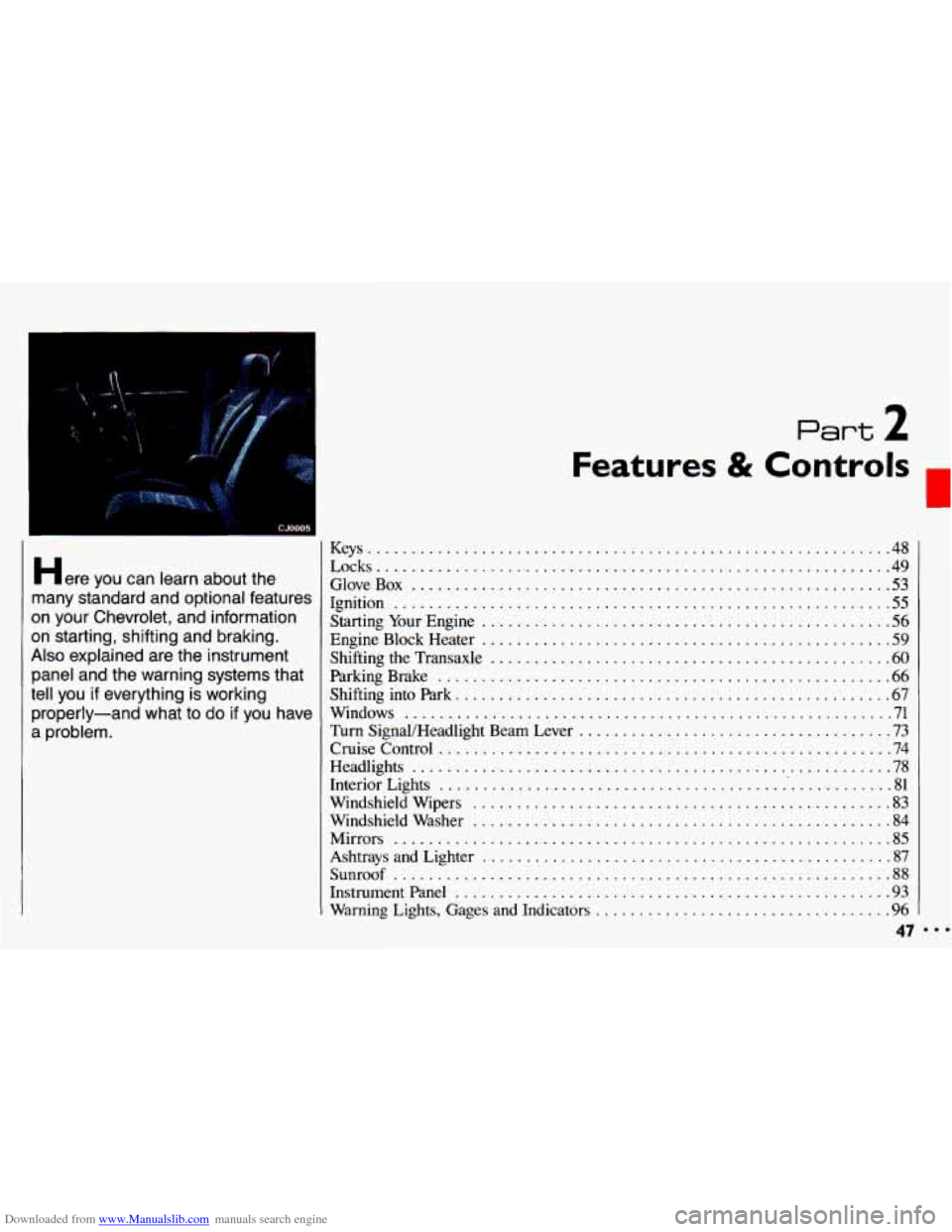
Downloaded from www.Manualslib.com manuals search engine ..
.; . I
Here you can learn about the
many standard and optional features
on your Chevrolet. and information
on starting. shifting and braking
.
Also explained are the instrument
panel and the warning systems that
tell you
if everything is working
properly-and what to
do if you have
a problem
.
Part 2
Features & Controls
Keys ............................................................ 48
Locks ........................................................... 49
GloveBox ....................................................... 53
Ignition ......................................................... 55
StartingYourEngine ............................................... 56
Engine Block Heater ............................................... 59
Shifting the Transaxle
.............................................. 60
ParkingBrake .................................................... 66
ShiftingintoPark .................................................. 67
Windows
........................................................ 71
Turn SignaVHeadlight Beam Lever
................................... -73
Cruisecontrol
.................................................... 74
Headlights
....................................................... 78
Interior Lights
.................................................... 81
Windshield Wipers
................................................ 83
Windshield Washer
................................................ 84
Mirrors
......................................................... 85
Ashtrays and Lighter
............................................... 87
Sunroof ......................................................... 88
Instrumentpanel .................................................. 93
Warning Lights, Gages and Indicators
.................................. 96
47
c
...
Page 61 of 308
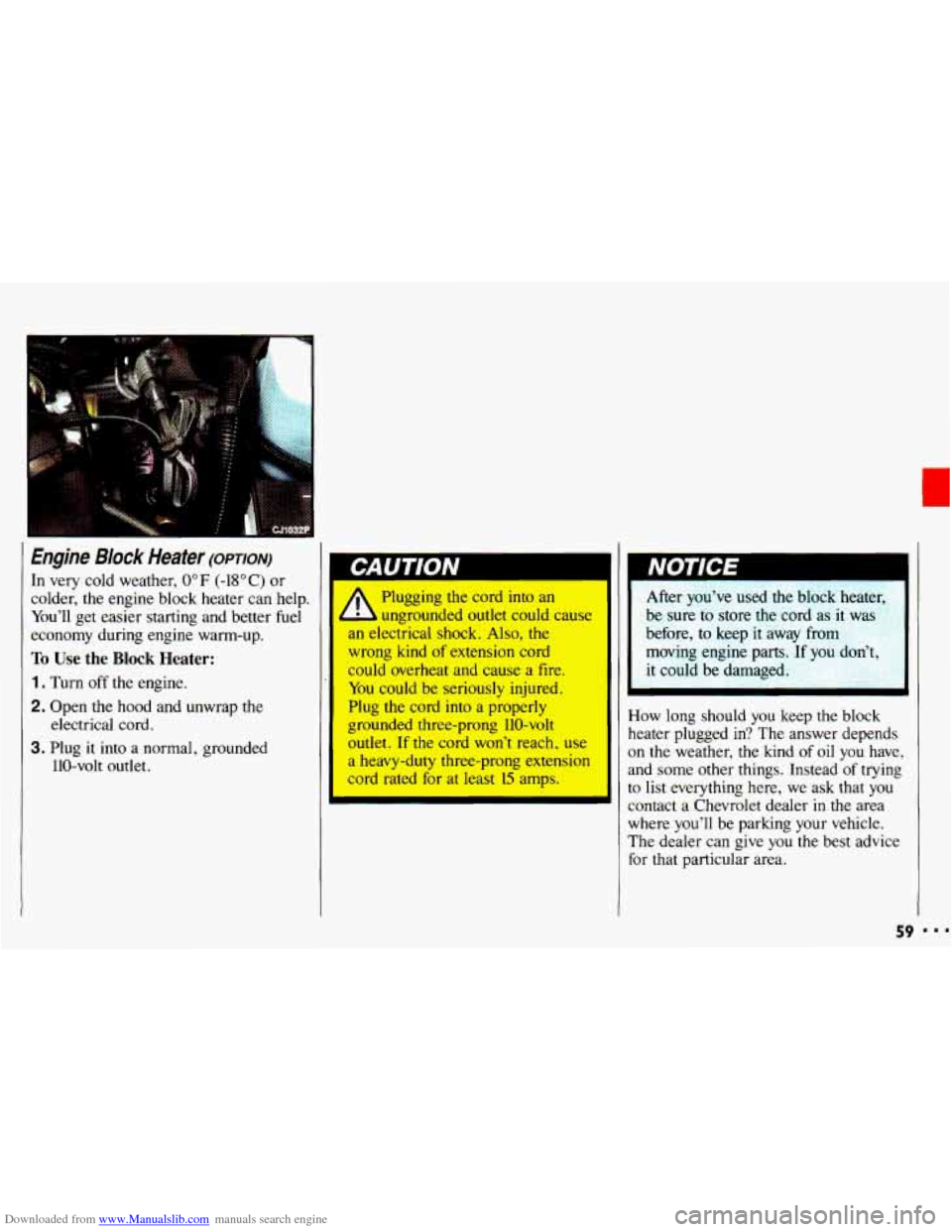
Downloaded from www.Manualslib.com manuals search engine Engine Block Heater (OPTION)
In very cold weather, 0°F (-18°C) or
colder, the engine block heater can help.
You’ll get easier starting and better fuel
economy during engine warm-up.
To Use the Block Heater:
1. Turn off the engine.
2. Open the hood and unwrap the
3. Plug it into a normal, grounded
electrical cord.
110-volt
outlet.
A
Plugging the cord into an
ungrounded outlet could cause
an electrical shock. Also, the
wrong kind
of extension cord
could overheat and cause a
fire.
You could be seriously injured.
Plug the cord into a properly
grounded three-prong 110-volt
outlet.
If the cord won’t reach, use
a heavy-duty three-prong extension
cord rated for at least
15 amps. After
you’ve
used the bfock hea,,,
be sure to store the cord as it was
before, to keep it away from
moving engine parts. If
you don’t,
it could be damaged.
How long should
you keep the block
heater plugged in? The answer depends
on the weather, the
kind of oil you have,
and some other things. Instead of trying
to list everything here,
we ask that you
contact a Chevrolet dealer
in the area
where you’ll be parking
your vehicle.
The dealer can give
you the best advice
for that particular area.
59 I..
Page 108 of 308
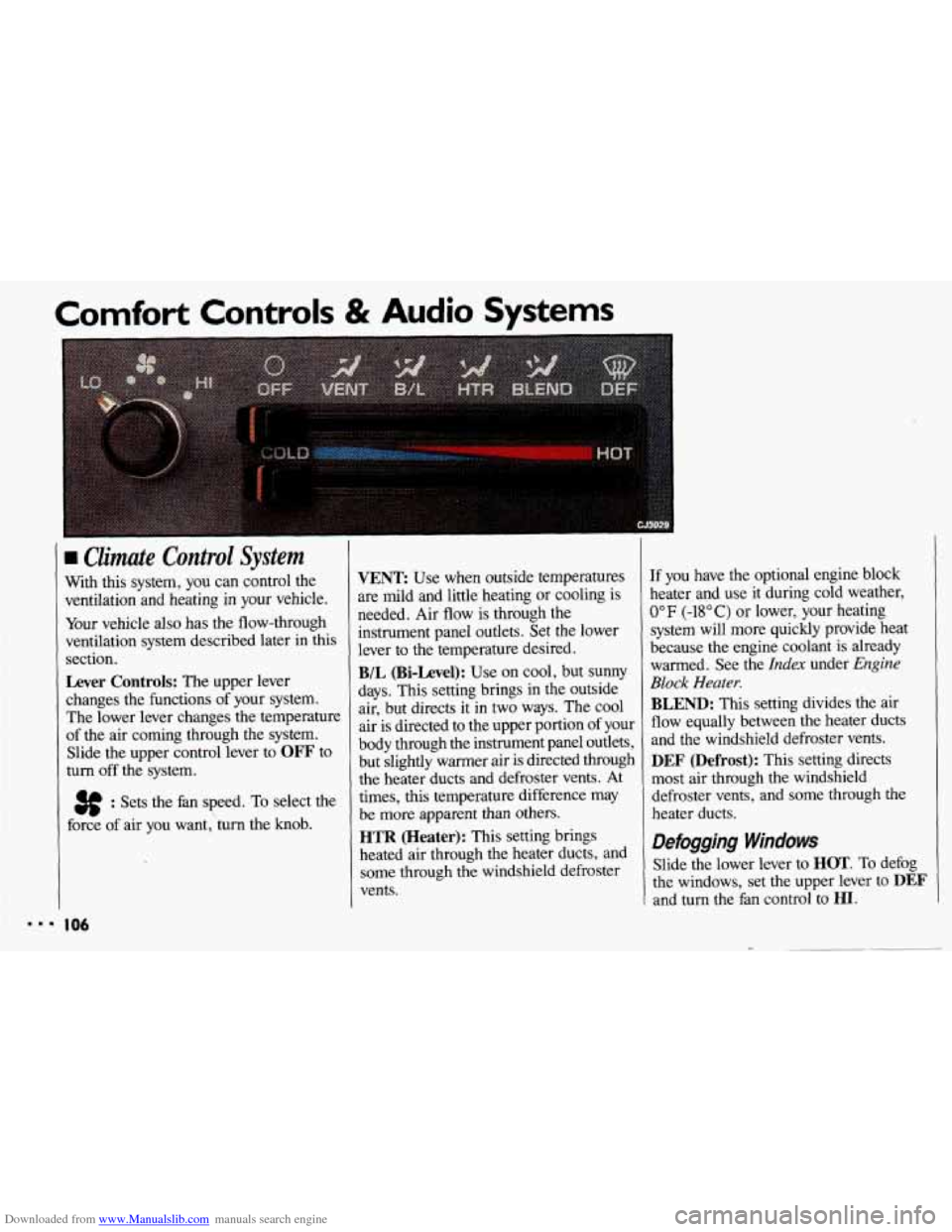
Downloaded from www.Manualslib.com manuals search engine Comfort Controls & Audio Systems
Climate Control System
With this system, you can control the
ventilation and heating in your vehicle.
Your vehicle
also has the flow-through
ventilation system described later in this
section.
Lever Controls: The upper lever
changes the functions of your system.
The lower lever changes the temperature
of the air coming through the system.
Slide the upper control lever to
OFF to
turn
off the system.
3f : Sets the fan speed. To select the
force of air you want,'turn the knob.
I06
VENT Use when outside temperatures
are mild and little heating or cooling is
needed. Air flow is through the
instrument panel outlets. Set the lower
lever to the temperature desired.
B/L (Bi-Level): Use on cool, but SUMY
days. This setting brings in the outside
air, but directs it in
two ways. The cool
air is directed to the upper portion of your
body through the instrument panel outlets,
but slightly warmer air is directed through
the heater ducts and defroster vents. At
times, this temperature difference may
be more apparent than others.
HTR (Heater): This setting brings
heated air through the heater ducts, and
some through the windshield defroster
vents.
If you have the optional engine block
heater and use it during cold weather,
0°F (-18°C) or lower, your heating
system will more quickly provide heat
because the engine coolant is already
warmed. See the
Index under Engine
Block Heater.
BLEND: This setting divides the air
flow equally between the heater ducts
and the windshield defroster vents.
DEF (Defrost): This setting directs
most air through the windshield
defroster vents, and some through the
heater ducts.
Defogging Windows
Slide the lower lever to HOT. To defog
the windows, set the upper lever to
DEF
and turn the fan control to HI.
Page 109 of 308
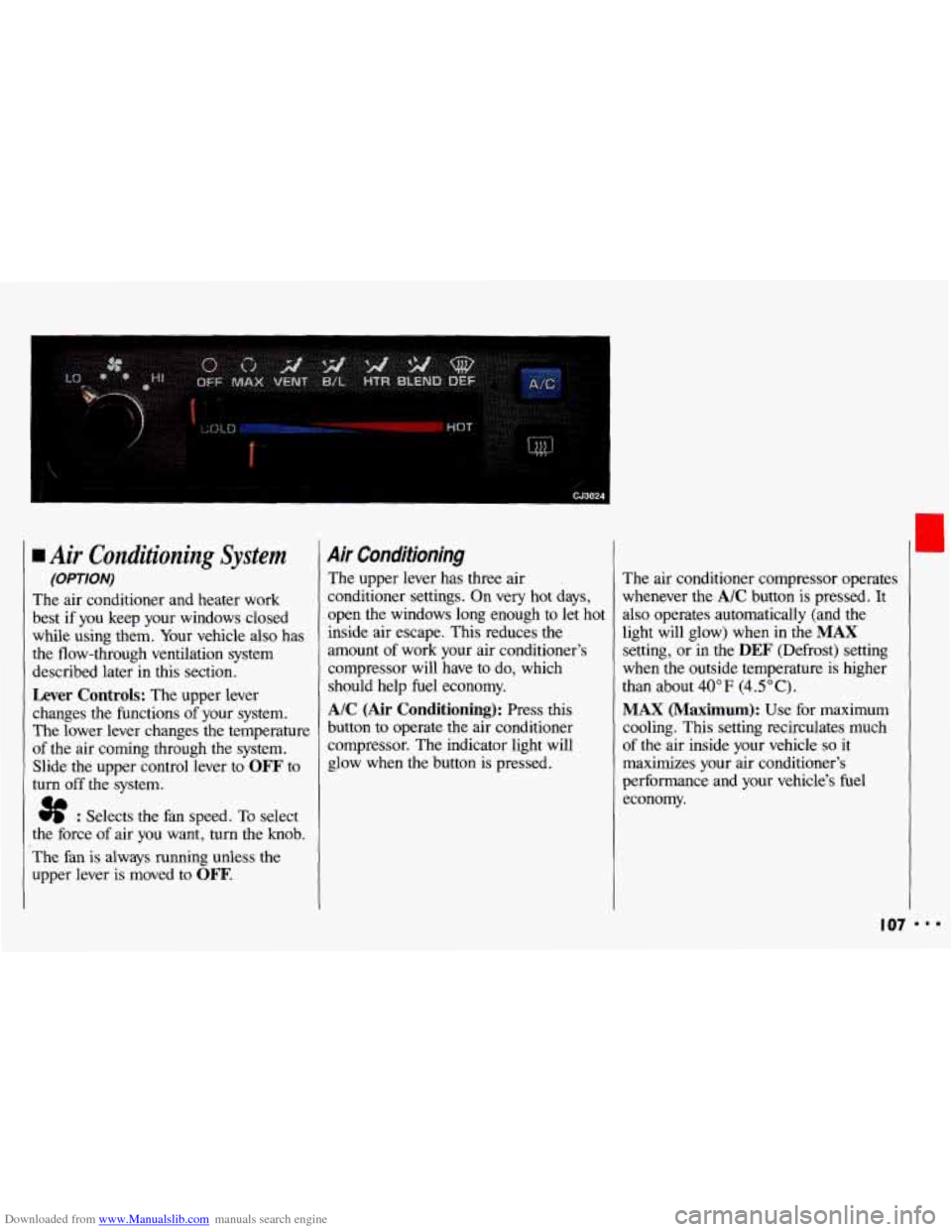
Downloaded from www.Manualslib.com manuals search engine r
Air Conditioning System
(OPTION)
The air conditioner and heater work
best if you keep your windows closed
while using them. Your vehicle also has
the flow-through ventilation system
described later in this section.
Lever Controls: The upper lever
changes the functions
of your system.
The lower lever changes the temperature
of the air coming through the system.
Slide the upper control lever to
OFF to
turn off the system.
I 3f : Selects the fan speed. To select
the force of air you want, turn the knob.
The fan is always running unless the
upper lever is moved to
OFF.
Air Conditioning
The upper lever has three air
conditioner settings.
On very hot days,
open the windows long enough to let hot
inside air escape. This reduces the
amount of work your air conditioner's
compressor will have to do, which
should help fuel economy.
A/C (Air Conditioning): Press this
button to operate the air conditioner
compressor. The indicator light will
glow when the button
is pressed. The air conditioner compressor
operates
whenever the
AIC button is pressed. It
also operates automatically (and the
light will glow) when in the
MAX
setting, or in the DEF (Defrost) setting
when the outside temperature is higher
than about
40°F (4.5"C).
MAX (Maximum): Use for maximum
cooling. This setting recirculates much
of the air inside your vehicle
so it
maximizes your air conditioner's
performance and your vehicle's fuel
economy.
I07
r
IIB
Page 110 of 308
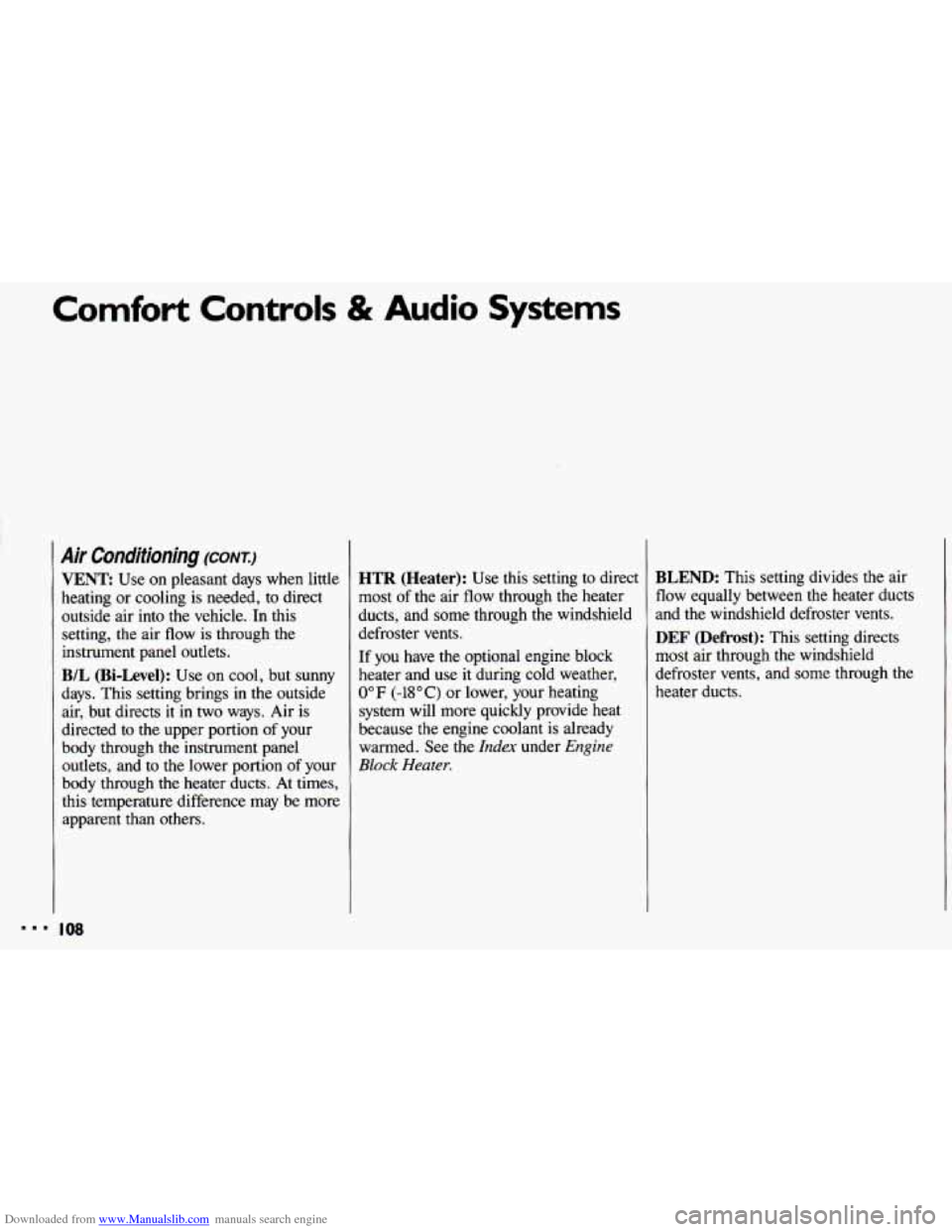
Downloaded from www.Manualslib.com manuals search engine Comfort Controls & Audio Systems
Air Conditioning (CONX:)
VENT Use on pleasant days when little
heating or cooling is needed,
to direct
outside air into the vehicle.
In this
setting, the air flow
is through the
instrument panel outlets.
B/L (Bi-Level): Use on cool, but sunny
days. This setting brings in the outside
air, but directs it in two ways. Air is
directed to the upper portion
of your
body through the instrument panel
outlets, and to the lower portion of your
body through the heater ducts. At times,
this temperature difference may be more
apparent than others.
HTR (Heater): Use this setting to direct
most of the air flow through the heater
ducts, and some through the windshield
defroster vents.
If
you have the optional engine block
heater and use
it during cold weather,
0°F (-18°C) or lower, your heating
system will more quickly provide
heat
because the engine coolant is already
warmed. See the
Index under Engine
Block Heater.
BLEND: This setting divides the air
flow equally between the heater ducts
and the windshield defroster vents.
DEF (Defrost): This setting directs
most air through the windshield
defroster vents, and some through the
heater ducts.
Page 112 of 308
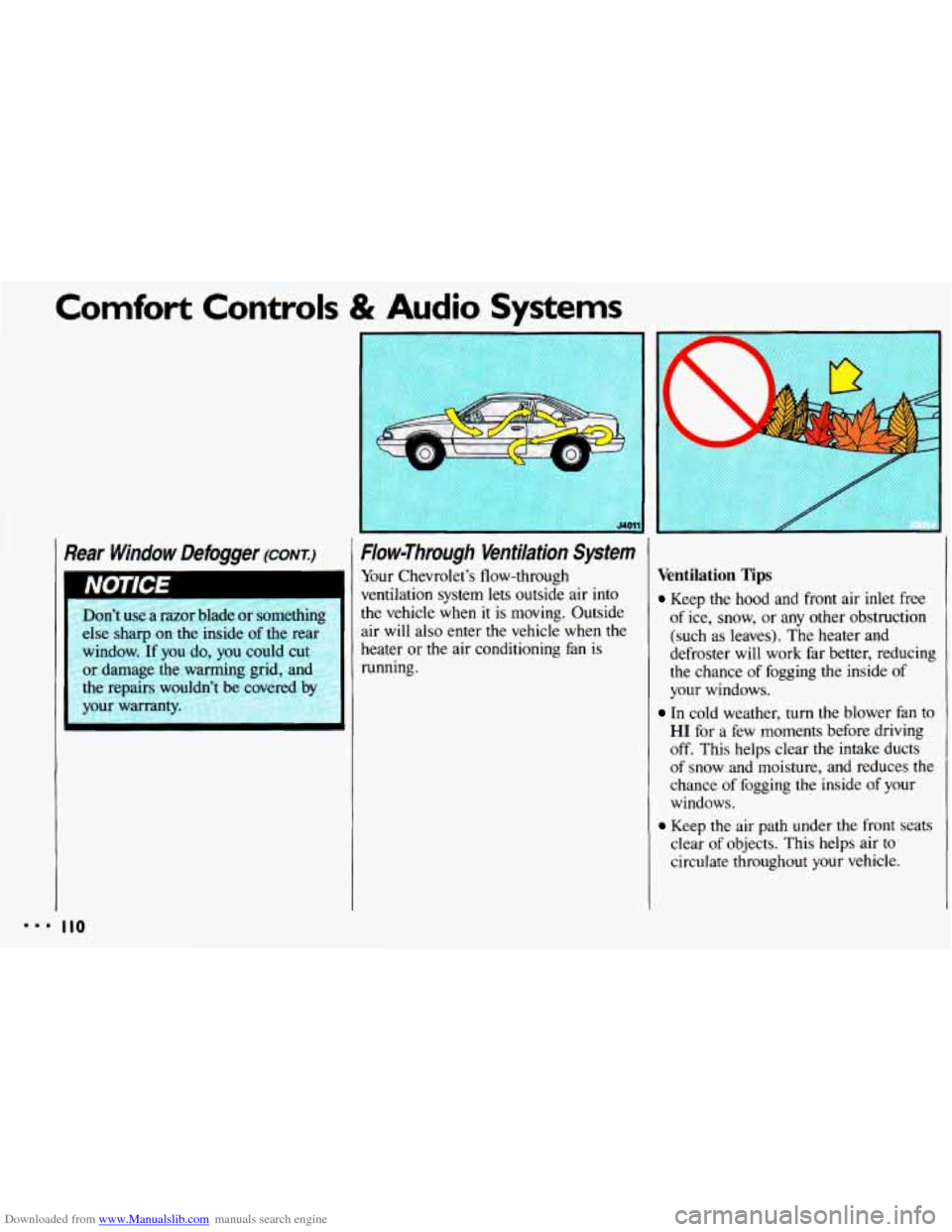
Downloaded from www.Manualslib.com manuals search engine Comfort Controls & Audio Systems
r
?ear Window Defogger (cow.)
Don’t use a razor blade or something
else sharp on the inside
of the rear
window. If you do,
you could cut
or damage
the warming grid, and
the repairs wouldn’t be covered by
your warranty.
Flow-Through Ventilation System
Your Chevrolet’s flow-through
ventilation system lets outside air into
the vehicle
when it is moving. Outside
air
will also enter the vehicle when the
heater or the air conditioning fan is
running.
Ventilation Tips
Keep the hood and front air inlet free
of ice, snow, or any other obstruction
(such as leaves). The heater and
defroster
will work far better, reducing
the chance
of fogging the inside of
your windows.
In cold weather, turn the blower fan to
HI for a few moments before driving
off.
This helps clear the intake ducts
of snow and moisture, and reduces the
chance of fogging the inside of your
windows.
Keep the air path under the front seats
clear of objects. This helps air
to
circulate throughout your vehicle.
Page 162 of 308
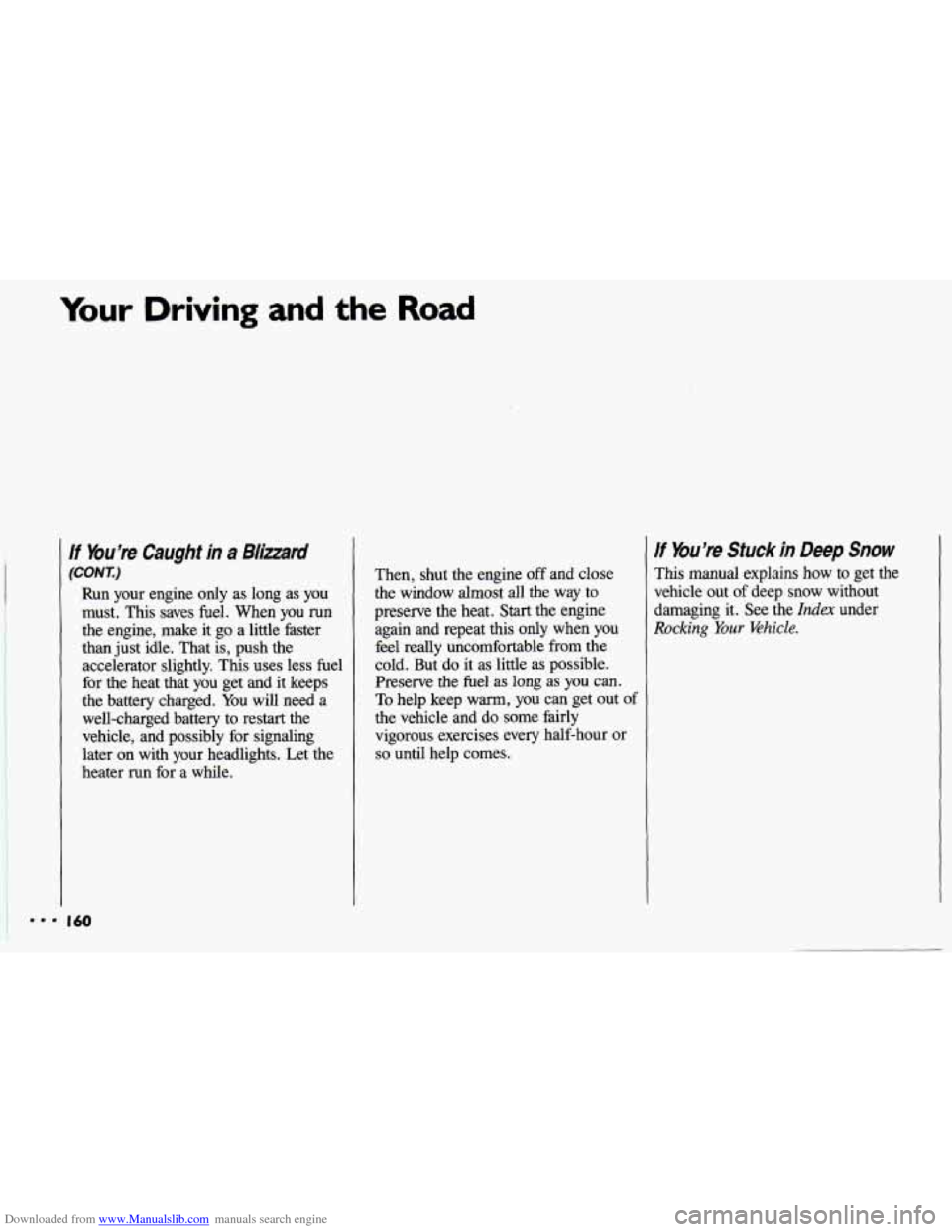
Downloaded from www.Manualslib.com manuals search engine Your Driving and the Road
lf bu're Caught in a Blind
(CONT)
Run your engine only as long as you
must, This saves fuel. When
you run
the engine, make it go a little faster
than just idle. That is, push the
accelerator slightly. This uses less fuel
for the heat that you get and it
keeps
the battery charged. You will need a
well-charged battery to restart the
vehicle, and possibly
for signaling
later on with your headlights. Let the
heater run
for a while. Then,
shut the engine
off and close
the window almost all the way to
preserve the heat.
Start the engine
again and repeat this only when you feel really uncomfortable from the
cold.
But do it as little as possible.
Preserve the fuel
as long as you can.
To help keep
warm, you can get out of
the vehicle and do some fairly
vigorous exercises every half-hour
or
so until help comes.
If You're Stuck in Deep Snow
This manual explains how to get the
vehicle out of deep snow without
damaging it. See the
Index under
Rocking Your Ehicle.
Page 177 of 308

Downloaded from www.Manualslib.com manuals search engine If you get the overheat warning with no
sign
of steam, try this for a minute or so:
1. If you have an air conditioner, turn it
2. Turn on your heater to full hot at the
off.
highest fan speed and open the window as necessary.
3. Try to keep your engine under load
(in a drive gear where the engine
runs slower).
If
you no longer have the overheat
warning, you can drive. Just to be safe,
drive slower for about ten minutes. If
the warning doesn’t come back on, you
can drive normally.
If the warning continues, pull over, stop, and park your vehicle right away. If there’s
still no sign of steam, you can
idle the engine for two or three minutes
while you’re parked, to see
if the
warning stops. But then, if you still have
the warning, TURN
OFF THE
ENGINE AND
GET EVERYONE
OUT OF THE VEHICLE until it cools
down.
You may decide not to
lift the hood but
to get service help right away.
If you have
a 2.2L L4 engine, your
engine coolant system
will have a
coolant recovery
tank. If you have a 3.1L
V6 engine, your engine coolant system
will have a coolant surge tank.
There are important differences between
these two cooling systems. Read this section carefully.
Cooling System-2.2L LA Engine
When you decide it’s safe to lift the
hood, here’s what you’ll see:
(A) Coolant recovery tank
(B) Radiator pressure cap
(C) Electric engine fan
a An electric fan under the hood
engine
is not running and can injure
you. Keep hands, clothing and tools
away
from any underhood electric h.
L can start up even when the
If the coolant inside the coolant
recovery tank
is boiling, don’t do
anything else until it cools down.
I75